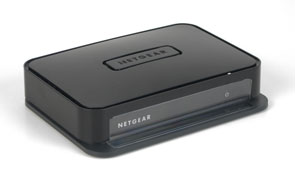Toshiba Satellite E205-S1904 WiDi Laptop Review
Setting up the E205's wireless display (WiDi) technology is very easy. The first thing you need to do is connect the Netgear Push2TV WiDi receiver to your TV. The Push2TV device has both HDMI and composite video outputs; if you use the RCA composite-out jack you'll also need to use the stereo-out RCA jacks as well (the HDMI port carries audio as well as video, so you don't need separate audio connections with HDMI). The HDMI output supports up to 720p, while the composite output is limited to 480i.
When you power up the Push2TV receiver, it takes a few moments for the device to boot up. Once it is ready to wirelessly receive a signal from the E205 (or any other WiDi device for that matter), a message appears on the screen that states the device is "ready for connection." To make the connection you need to launch the Intel Wireless Display app on the E205--you can launch the app from the Start menu or by using the dedicated function key to the right of the keyboard. When the app launches, it displays all of the WiDi adapters that it detects. If the app doesn't detect the receiver, one of two things are likely going on: either the receiver isn't powered on, or the E205's Wi-Fi adapter is turned off. The WiDi technology uses Wi-Fi frequencies, so you need to make sure that the E205's Wi-Fi adapter is enabled.
With the Intel Wireless Display app, you simply select Push2TV from the list of detected adapters and click the Connect button to make the connection--the Push2TV will likely be the only WiDi receiver detected, and therefore will be selected by default. You can also set the Intel Wireless Display app to automatically connect to the Push2TV whenever you launch the app. When the E205 connects to the Push2TV, the laptop changes screen resolution from its native 1366x768 to 1280x768. When the E205 is in 1280x768 mode, the image doesn't fill the entire 14-inch screen--there are about half-inch black bands on either side of the screen. Establishing the connection takes only a few seconds.
With the connection established, the E205's display is mirrored to your TV. Using the Push2TV's HDMI output for video and audio we were impressed with both the image and audio quality of the connection. There was some barely noticeable image degradation from the original source content, but when viewed from 10 or so feet away on a large-screen TV, you might not notice the difference. What is unmistakably noticeable, however, is the lag between what the E205 displays on its screen and what you see displayed on the TV. This delay is less than a second, but it is long enough that you're not going to want to use WiDi for any tasks that require real-time interaction, such as using productivity apps or especially for gaming.
As such, WiDi is really best suited for more passive usage scenarios, such as watching videos or photos and listening to music. Business users might get value out of WiDi by using it for presentations. One thing you are not going to be able to use WiDi for, however, is for watching protected content, such as protected commercial DVDs or Blu-ray movies. If you try to watch protected content over WiDi, you'll get an error message that states, "there is a problem with digital copy protection between your DVD drive, decoder, and video card"--which is a message that should be familiar to anyone who has tried to watch protected content over a digital connection (such as DVI or HDMI) with a display that was not HDCP compliant.












